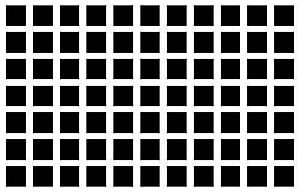Lateral inhibition facts for kids
Lateral inhibition is a clever trick your brain uses to help you understand the world better. It's a process where an active brain cell, called a neuron, can reduce the activity of its nearby neighbors. Think of it like a spotlight: when one area is brightly lit, the areas right next to it seem even darker by comparison. This helps your brain make things stand out more clearly.
This process stops signals from spreading too much sideways, or "laterally," in your brain. It's called "lateral inhibition" because it "inhibits" (stops or slows down) the activity of neighboring neurons. This creates a stronger contrast between what your brain is focusing on and what's around it. This improved contrast helps you notice details and differences more easily.
Contents
How Lateral Inhibition Works
Lateral inhibition is super important for your senses. It helps you see clear edges, feel distinct touches, and even hear specific sounds.
Seeing Clearly
One of the best examples of lateral inhibition is in your vision. Imagine looking at a black and white image. Lateral inhibition helps your eyes and brain make the edges between black and white areas look sharper. Without it, everything might seem a bit blurry or blended. It helps you tell exactly where one object ends and another begins.
Other Senses
While it's most noticeable in vision, lateral inhibition also plays a role in other senses:
- Touch: It helps you pinpoint exactly where you're being touched, rather than feeling a general pressure over a wide area.
- Hearing: It can help you focus on a specific sound, like a friend's voice, even when there's a lot of background noise.
- Smell: It might help you distinguish between different scents.
Where it Happens
The brain cells that use lateral inhibition are mainly found in parts of your brain called the cerebral cortex and the thalamus. These areas are like control centers for processing sensory information. They work together in what are called lateral inhibitory networks.
Lateral Inhibition in Technology
Scientists and engineers have even used the idea of lateral inhibition to create new technologies. For example, some artificial sensory systems, like those in vision chips (used in cameras or robots), hearing systems, and even optical computer mice, use similar principles. This helps these devices "see" or "hear" more clearly, just like your brain does!
Images for kids
See also
 In Spanish: Inhibición lateral para niños
In Spanish: Inhibición lateral para niños




